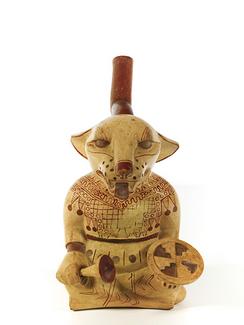
Photo: Jorge Bastos
Long-term loan MASP Landmann — Pre-Columbian ceramics and metals Exposition collective
MASP — Museu de Arte de São Paulo Assis Chateubriand presents, from June 30th to September 3rd, the exhibition Comodato MASP Landmann — cerâmicas e metais pré-colombianos [Long-term loan MASP Landmann — Pre-Columbian ceramics and metals], held on the 2nd basement floor of the museum. Curated by Marcia Arcuri, MASP adjunct curator of pre-Columbian art, with support of Leandro Muniz, MASP assistant curator, the show gathers 721 pre-Columbian artifacts produced by indigenous people from America between the 2nd century b.c. and the 16th century, and it is accompanied by the launching of a catalogue with three unpublished essays in Portuguese. The show is supported by JP Morgan.
This is the second show dedicated to the long-term loan of the Pre-Columbian art collection of Edith and Oscar Landmann, lent in 2016 for 10 years to the museum. The first presented a series of fabric and was exhibited in 2019, a year dedicated to the history of women, feminist history. In the years before, 2017 and 2018, two seminars were held on the theme. Now, the public finally has access to the objects from the long-term loan, attributed to 35 archeological cultures from America. Items from Chavín, Paracas, Nasca, Moche, Huari, Lambayeque, Chimú, Chancay, Inca, Calima, Tolima, Zenú and Muísca cultures, as well as the Marajoara culture, from the Brazilian Amazon, are present in this show and constitute an extensive historic and scientific legacy built by the populations that lived where today we find Ecuador, Peru, Colombia, Venezuela, Panama, Mexico, Brazil and the Caribbean countries.
The show gathers artifacts that reflect plural ideas, gestures, techniques and material practices especially in ceramics and metal, but also in wood, stone and bones, objects that also have feathers, fibers and pigments made from minerals or plants. “The history of the indigenous populations of America is distant from most Brazilians, being practically absent from the bibliographic references and textbooks produced in the country. On the other hand, there is a dissemination of archeological and ethnographic knowledge on the Indigenous America through museums and other art institutions. This is the background that presents the second show of the long-term loan MASP Landmann”, states the adjunct curator, Marcia Arcuri.
To identify the origin of the objects in the collection, the researchers’ methodologies can detect similarities in the style of different artifacts, and from that, compare and analyze them in a set of cultural elements. Based on information on the items found in archeological backgrounds, the styles can be associated to certain distribution areas and time periods. However, the spatial and chronological boundaries of the so-called archeological cultures are not always clear and, each time, new field researches and excavations lead to a review of the previous comprehension.
“Reevaluation of the archeological data interpretation will always happen, given that there is still a lot to be explored in field researches”, explains Arcuri. And she continues: “The nature of archeological science requires an extensive investment (of personal, financial and technological resources), an ongoing dialogue with the reexamination of theoretical paradigms of knowledge productions and, above all, the social commitment to the contemporary indigenous population”.
“We understand that some common segments that underlie the historical aspects of each item’s production can be understood as structuring elements of the native American social cosmogony. When we assume the potential of the archeological collections to the scientific investigation, we value the collectors view that kept an attentive eye to the world of the selected objects, an important element in the Landmann collection”, concludes the adjunct curator.
Long-term loan MASP Landmann — Pre-Columbian ceramics and metals is part of MASP’s 2023 program dedicated to Indigenous Histories. This year the agenda includes shows by Carmézia Emiliano, MAHKU, Paul Gauguin, Sheroanawe Hakihiiwe, Melissa Cody, and also the collective exhibit Indigenous Histories.
CATALOGUE
In order to expand the knowledge on cultural and scientific heritage of the native American people, a catalogue, available in Portuguese, was developed to the show and gathers three essays, in addition to images of the archeological pre-Columbian artworks. The book is organized by Marcia Arcuri, with the assistance of Leandro Muniz, and includes introductions by Adriano Pedrosa and Julio Landmann, essays by George Lau, Marcia Arcuri, Marcos Martinón-Torres and María Alicia Uribe Villegas. With the design signed by Edilaine Cunha, the publication has 408 pages and over 800 images, including maps and a presumed chronology. One of the highlights in the publication is the emphasis on the social cosmogony of the native American.
Only a few art collections in the world gather such a meaningful ensemble, capable of revealing the ethnic and cultural diversity of the ancient past of the American continent. The items are attributed to 35 distinct “archeological cultures”, a definition of a set of artifacts that have common vision, technology and style and that make it possible to speculate cultural and temporal boundaries, as well as processes of interaction and trade between different pre-Columbian populations.
ABOUT LONG-TERM LOAN MASP LANDMANN
Since 2016, the Long-term loan MASP Landmann is in place, establishing a lending contract with The Edith and Oscar Landmann Collection – acknowledged as one of the most important archives of pre-Columbian art in Latin America and as one of the few exhibited in Brazilian museums. Throughout over 50 years, Oscar and Edith Landmann gathered 906 pieces of pre-Columbian artworks, including fabrics, ceramics and metals. There are works produced by different people, most of them in South America, between 1200 b.C and the 16th century — over 2500 years.